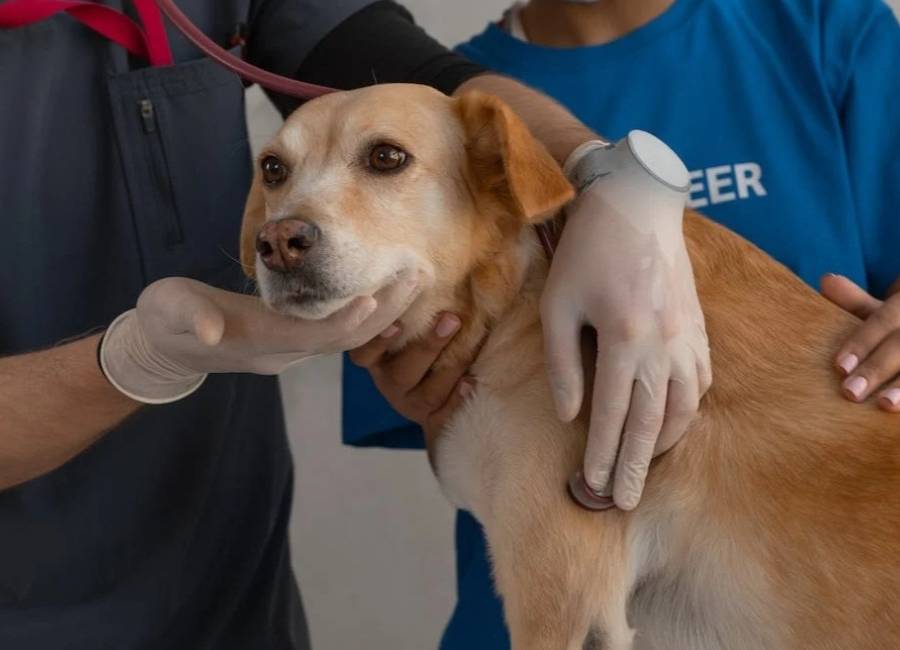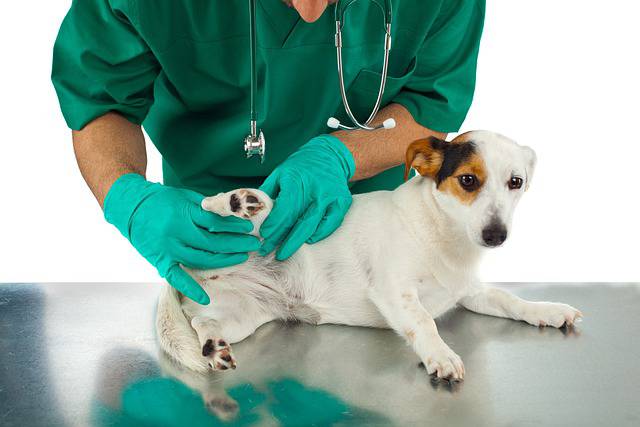12 Potential Symptoms of Ear Infection in Dogs

If you’ve ever noticed your furry friend scratching their ears incessantly or tilting their head to one side, it could be a sign of an ear infection.
In this blog post, we’ll explore the telltale symptoms of ear infections in dogs, so you can quickly spot the issue and seek the necessary help.
So, let’s dive in!
Causes of Ear Infections in Dogs
Ear infections in dogs can be caused by various factors, including allergies, bacterial or yeast overgrowth, and foreign objects in the ear.
Allergies, such as food or environmental sensitivities, can lead to inflammation and increased production of earwax, creating an ideal environment for infection.
Bacterial or yeast overgrowth can occur due to excessive moisture in the ear canal or a weakened immune system, leading to infection.
Additionally, foreign objects, such as grass awns or dirt, can irritate the ear canal and result in infection.
Let’s look at the symptoms of ear infection in dog…
Symptoms of Ear Infection in Dogs
Symptoms of ear infection in dogs may include redness, swelling, and discharge in the ear canal.
Dogs with ear infections may also exhibit signs of discomfort, such as frequent head shaking or scratching at the affected ear.
A foul odor and a loss of balance can also be indicative of an ear infection in dogs.
Let’s break it down further…
The following are some common symptoms of ear infection in dogs:
1. Constant Head Tilting
Constant head tilting is a common symptom of an ear infection in dogs. When a dog has an ear infection, it can cause irritation and discomfort in the affected ear, leading to the dog tilting its head to one side.
This is often accompanied by other signs of pain or discomfort, such as whining or whimpering.
The constant head tilting is the dog’s way of trying to alleviate the discomfort caused by the infection.
It’s important to note that while head tilting can be a symptom of an ear infection, it can also be a sign of other underlying health issues, so it’s important to consult a veterinarian for a proper diagnosis.
2. Frequent Head Shaking
Another symptom of an ear infection in dogs is frequent head shaking. Dogs with ear infections will often shake their heads vigorously in an attempt to relieve the discomfort caused by the infection.
The shaking helps to dislodge any debris or fluid that may be trapped in the ear canal.
If you notice your dog shaking its head excessively and repeatedly, it may be a sign of an ear infection and should be evaluated by a veterinarian.
3. Constantly Pawing at the Ear
Constantly pawing at the ear is another common symptom of an ear infection in dogs. The irritation and discomfort caused by the infection can lead to excessive scratching or pawing at the affected ear.
The dog may try to scratch the ear using its paws or rub the ear against furniture or the ground. This behavior is a result of the dog’s attempt to alleviate the itchiness or pain in the ear.
However, excessive scratching or pawing can further irritate the ear and potentially lead to more serious complications, so it’s important to seek veterinary care.
4. Swelling and Redness of the Ear
Swelling and redness of the ear are also symptoms of an ear infection in dogs.
The infection can cause inflammation in the ear, leading to swelling and redness of the affected area.
In some cases, the ear may appear swollen and feel warm to the touch. The redness and swelling may be accompanied by discharge or a foul odor from the ear.
These symptoms indicate an active infection and should be addressed by a veterinarian.
5. Discharge From the Ear (yellow, brown, or bloody)
When a dog has an ear infection, one common symptom is the presence of discharge from the affected ear.
The discharge can vary in color, ranging from yellow to brown or even bloody. The discharge may have a foul smell and can be a sign of an underlying infection or inflammation in the ear.
It is important to note that ear discharge alone is not enough to diagnose an ear infection, as other conditions such as ear mites or foreign objects in the ear can also cause discharge.
If you notice a discharge from your dog’s ear, it is recommended to consult with a veterinarian for a proper diagnosis and appropriate treatment.
Read more about deafness in dogs.
6. Strong Odor From the Ear
Another symptom of an ear infection in dogs is a strong odor emanating from the affected ear.
The odor is usually unpleasant and can be described as a foul smell. The strong odor is often caused by the presence of bacteria or yeast that thrive in the warm and moist environment of the infected ear.
This odor is distinct and can be a helpful indicator that there is an underlying problem in the ear.
If you notice a strong odor coming from your dog’s ear, it is advisable to seek veterinary attention to determine the cause and appropriate treatment.
7. Loss of Balance
Loss of balance, also known as vestibular dysfunction, can be a symptom of an ear infection in dogs.
The inner ear plays a crucial role in maintaining balance, and when it becomes infected or inflamed, it can disrupt the dog’s sense of balance.
Dogs with an ear infection may exhibit symptoms such as stumbling, falling over, head tilting, or walking in circles.
These symptoms can be alarming and may indicate a more severe infection or involvement of the middle or inner ear.
If your dog is experiencing loss of balance, it is important to consult with a veterinarian for a proper evaluation and treatment.
8. Pain and Sensitivity Upon Touching the Ear
Pain and sensitivity upon touching the ear is a common symptom of an ear infection in dogs.
The infected ear may be tender to the touch, and your dog may show signs of discomfort or pain when you attempt to examine or touch the affected ear.
Dogs may shake their heads, scratch at their ears, or rub their ears against objects in an attempt to alleviate the pain or itchiness. It is essential to handle the infected ear gently and avoid causing further discomfort to your dog.
If you suspect your dog has an ear infection and notice signs of pain or sensitivity, it is recommended to seek veterinary care for a proper diagnosis and appropriate treatment.
9. Dog Having Trouble Hearing
One of the symptoms of an ear infection in dogs is when they have trouble hearing.
Ear infections can cause inflammation and swelling in the ear canal, which can affect a dog’s ability to hear properly.
If you notice that your dog is not responding to sounds as they normally would, or if they seem to be ignoring commands or not reacting to noises, it could be a sign of an ear infection.
10. Presence of Crustiness or Scabs in the Dog’s Ear
Another symptom of an ear infection in dogs is the presence of crustiness or scabs in the dog’s ear.
Ear infections can cause irritation and discharge in the ear, which can lead to the formation of crusts or scabs.
You may notice a brown, yellow, or bloody discharge in your dog’s ear, and if left untreated, this can lead to the formation of crusts or scabs.
These crusts or scabs can be painful and itchy for your dog, and they may try to scratch or shake their head to relieve the discomfort.
Read more about how to clean your dog’s ears.
11. Changes in Behavior
Changes in behavior can also be a symptom of an ear infection in dogs. Ear infections can be painful and uncomfortable for dogs, and they may exhibit changes in behavior as a result.
Your dog may become more irritable or aggressive, or they may seem lethargic and less active than usual.
They may also show signs of discomfort when you touch or manipulate their ears, such as flinching, growling, or pulling away.
12. Abnormal Eye Movements or Eye Position
In some cases, ear infections in dogs can affect their vestibular system, which is responsible for maintaining balance and coordination.
If the infection spreads to the inner ear, it can cause abnormalities in the vestibular system, leading to symptoms such as abnormal eye movements or eye position.
Your dog may exhibit involuntary eye movements, such as rapid flickering or jerking, or their eyes may appear to be rolling or twitching.
They may also have difficulty maintaining their balance and may stumble or fall.
Read more about common dog ear problems.
Treatment Options for Ear Infections in Dogs
Ear infections in dogs can be quite common and can cause discomfort and pain for the dog.
Treatment options for ear infections in dogs may vary depending on the severity and underlying cause of the infection.
Here are some common treatment options:
1. Veterinary Examination: The first step in treating a dog’s ear infection is to take the dog to a veterinarian for a thorough examination. The vet will examine the ear canal, take a sample for testing, and determine the cause of the infection.
2. Cleaning the Ear: Cleaning the ear is an important part of the treatment process. The veterinarian may clean the ear using specialized ear cleaning solutions or recommend at-home ear cleaning solutions. Cleaning helps remove debris, wax, and any infection-causing agents.
3. Medications: Depending on the type and severity of the infection, the veterinarian may prescribe medications for the dog. These may include:
- Antibiotics: Antibiotics are commonly prescribed to treat bacterial infections. The veterinarian will prescribe the appropriate antibiotic based on the type of bacteria causing the infection.
- Antifungal Medications: If the ear infection is caused by a fungal infection, antifungal medications may be prescribed.
- Anti-inflammatory Medications: In cases where there is inflammation and pain, the veterinarian may prescribe anti-inflammatory medications to provide relief.
4. Topical Treatments: Topical treatments, such as ear drops or ointments, are often used to directly target the infection in the ear canal. These medications may contain antibiotics, antifungal agents, or anti-inflammatory drugs.
5. Follow-up Care: It is important to follow the veterinarian’s instructions for administering medications and cleaning the dog’s ears. Regular follow-up visits may be necessary to monitor the progress and ensure proper healing.
Frequently Asked Questions
What are the common signs that my dog may have an ear infection?
Look out for symptoms like frequent scratching or pawing at the ears, redness or swelling of the ear canal, foul odor, discharge, and sensitivity when the ears are touched. If you notice any of these signs, it’s best to consult your veterinarian.
Can ear infections in dogs cause hearing loss?
While ear infections themselves may not directly cause permanent hearing loss, chronic or untreated infections can lead to complications that may affect your dog’s hearing. It’s important to address ear infections promptly to prevent any potential damage.
Are certain dog breeds more prone to ear infections?
Yes, some dog breeds are more susceptible to ear infections due to factors like ear shape, hair growth in the ear canal, and allergies. Breeds with floppy ears, such as Cocker Spaniels and Basset Hounds, are often more prone to infections.
Can allergies contribute to ear infections in dogs?
Absolutely. Allergies can cause inflammation and increased moisture in the ears, creating an environment conducive to infection. If your dog has allergies, it’s important to manage them properly to reduce the likelihood of ear infections.
Read more about identifying ear mites in dogs.
Are ear infections in dogs contagious?
Ear infections in dogs are typically not contagious to humans or other pets. However, certain underlying conditions, like mites or bacteria, can be transmitted. It’s always best to consult your veterinarian for a proper diagnosis and guidance.
How can I prevent ear infections in my dog?
Regular ear hygiene is key to preventing ear infections. Clean your dog’s ears with a veterinarian-approved cleaning solution, and ensure they are dried properly after swimming or bathing. Regular check-ups with your vet can help identify any underlying issues early on and prevent infections from occurring.
Conclusion
In conclusion, if your furry friend is showing signs of an ear infection, it’s crucial to act swiftly. Remember, early detection can prevent discomfort and potential complications down the road.
So, keep an eye out for redness, odor, or excessive scratching, and consult your veterinarian for the best course of action. Your pup’s health is in your hands!

![Dog Not Eating But Throwing Up [9 Reasons & Tips] Dog Not Eating But Throwing Up](https://petcreeks.com/wp-content/uploads/2023/04/Dog-Not-Eating-But-Throwing-Up-768x555.jpg)




![Why Is My Dog Suddenly Sneezing So Much [8 Reasons] Why Is My Dog Suddenly Sneezing So Much](https://petcreeks.com/wp-content/uploads/2023/04/Why-Is-My-Dog-Suddenly-Sneezing-So-Much-768x555.jpg)